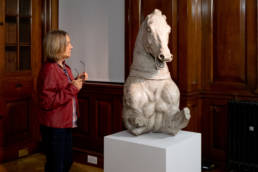Author Unknown
Second generation replica of The Lanuvium Marbles
Resin cast
The Lanuvium Marbles were commissioned by the Roman general, Lucullus, to commemorate his victory in the Mithridatic War in the first century BC. They originally consisted of nine horsemen, but when they were ‘discovered’ in 1886 by the British Ambassador to Italy, John Lumley-Savile, (1818–1896) only four remained. Lumley-Savile moved them to his Yorkshire estate before splitting them between the British Museum and Leeds Philosophical Society (now Leeds City Museum).
The horse’s head in Untitled was a resin cast of one of the marbles held in London, offering an opportunity to think about museum practices of Lumley-Savile’s day. In 1867, the South Kensington Museum (now the V&A), released a declaration that called for museums around the world to produce replicas and reproductions of objects in their collections that could be shared and exchanged with other museums. A cast court was opened in 1873, and the objects gathered during that period still form an important part of the V&A’s collection, operating as both stand-ins for original works, and representations of important developments in reproductive technologies.
A significant number of acquisitions by Manchester’s Whitworth Art Gallery, which opened in 1889, were also copies, primarily casts of classical sculpture. They were used to cultivate taste within, and offer instruction to, the city’s working-class communities. In 1905, however, The Art Gallery Committee of The City of Manchester stated that they no longer approved of such museological practices, as copies were misleading and lacked the trace of the artist’s touch. The Whitworth dispersed its cast collection to local schools in 1920.
This resin cast was present in the Ziff Gallery at Leeds Art Gallery when I made my video, Untitled in 2000, the work upon which the exhibition, Untitled, was based.
Exhibited in:
Loaned by:
Untitled
The Tetley, Leeds (24 Sept 2019 → 19 Jan 2020)
Leeds Art Gallery
The Headrow, Leeds
